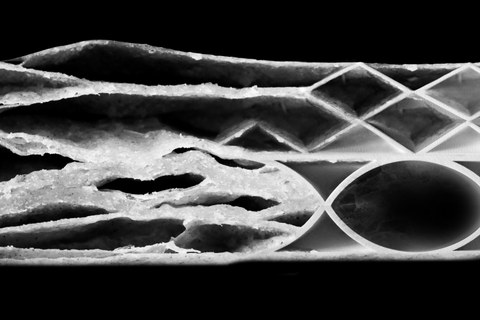Collaborative Research Center/Transregio 280
New materials make new designs and types of construction possible. What sounds so simple is often a long road in reality. In the construction industry, innovation processes take a particularly long time due to high safety and durability requirements and complex standardization and approval procedures. This also applies in particular to high-performance building material combinations such as textile and carbon concrete, which will bring about a paradigm shift or even a revolution in building with concrete, the world's most important building material in terms of quantity. Carbon concrete can significantly reduce the enormous consumption of resources andCO2 emissions of the construction industry, but also open up additional functions. However, initial construction projects have made it clear that despite the new possibilities, traditional construction principles borrowed from reinforced concrete are still being used, i.e. conventional materials are merely being substituted. Only in conjunction with intelligent construction strategies will the full potential of the innovative material carbon concrete be exploited in the future.

Konstruktionsstrategien für materialminimierte Carbonstrukturen. Grundlagen für eine neue Art zu bauen.
While previous research projects have investigated the fundamentals and applicability of the new material carbon reinforced concrete, this CRC/TRR with a total of 26 researchers is researching new construction strategies for carbon reinforced concrete. The aim is for the new material composite carbon concrete not only to replace the previous material reinforced concrete, but also to find new ways of construction that are specially tailored to the properties of carbon concrete in order to exploit the full performance potential of carbon concrete.
Appropriate methods for designing, modeling and constructing with new materials require in-depth basic research and a holistic approach. For carbon concrete, this means lightweight construction principles appropriate to the material. Botany as well as other construction-related disciplines such as mathematics and art are central sources of ideas for innovative construction elements that transfer forces primarily through normal stresses. The development of novel structures is closely linked to questions of manufacturability, taking into account an accompanying product-related sustainability assessment and adequate further development of the material composite itself. The design strategies that have been recognized as expedient enable a completely different design language. The new construction strategies and material combinations reduce resource and energy consumption through previously unknown lightweight construction principles, while at the same time offering high usability, load-bearing safety and durability, and are also reflected in a sophisticated aesthetic that can develop into a new "art of building". The long-standing research alliance between TUD and RWTH combines the existing excellent expertise and will play an internationally visible pioneering role in research into material-minimized construction with mineral composites.
The aim is to create the basis for the building of the future: completely rethought concepts for the design, modeling, construction, manufacture and use of sustainable, resource-efficient building elements made of mineral building materials.
Funding phase 1 (07/2020-06/2024)
Spokesperson: Prof. Dr.-Ing. Dr.-Ing. E.h. Manfred Curbach, TU Dresden
Partners: TU Dresden, RWTH Aachen University, IPF Dresden
Funding amount: approx. 12 million euros
Funding phase 2 (07/2024-06/2028)
Spokesperson: Prof. Dr.-Ing. Steffen Marx
Partners: TU Dresden, RWTH Aachen University, IPF Dresden, University of Hamburg
Botanical Garden
Funding amount: approx. 13.7 million euros
Project website: www.sfbtrr280.de
